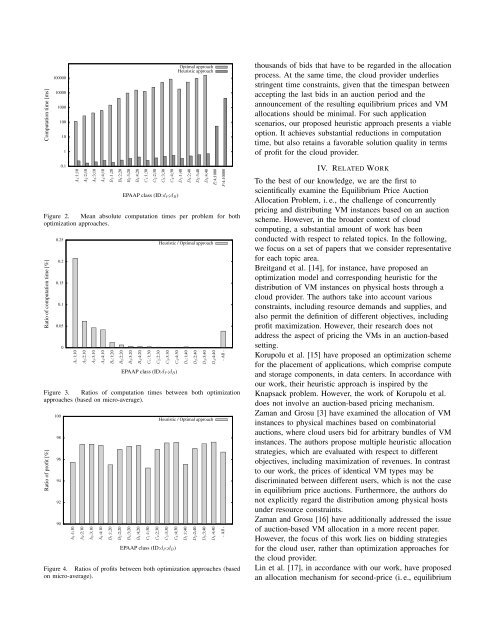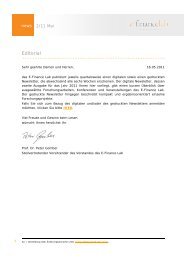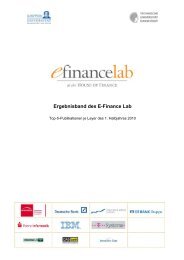Prof. Dr. Wolfgang König, Prof. Dr.-Ing. Ralf ... - E-Finance Lab
Prof. Dr. Wolfgang König, Prof. Dr.-Ing. Ralf ... - E-Finance Lab
Prof. Dr. Wolfgang König, Prof. Dr.-Ing. Ralf ... - E-Finance Lab
You also want an ePaper? Increase the reach of your titles
YUMPU automatically turns print PDFs into web optimized ePapers that Google loves.
Computation time [ms]<br />
100000<br />
10000<br />
1000<br />
100<br />
10<br />
1<br />
0.1<br />
A1:1;10<br />
A2:2;10<br />
A3:3;10<br />
A4:4;10<br />
B1:1;20<br />
B2:2;20<br />
B3:3;20<br />
B4:4;20<br />
C1:1;30<br />
C2:2;30<br />
C3:3;30<br />
C4:4;30<br />
EPAAP class (ID:dP ;dB)<br />
Optimal approach<br />
Heuristic approach<br />
Figure 2. Mean absolute computation times per problem for both<br />
optimization approaches.<br />
Ratio of computation time [%]<br />
0.25<br />
0.2<br />
0.15<br />
0.1<br />
0.05<br />
0<br />
A1:1;10<br />
A2:2;10<br />
A3:3;10<br />
A4:4;10<br />
B1:1;20<br />
B2:2;20<br />
B3:3;20<br />
B4:4;20<br />
C1:1;30<br />
C2:2;30<br />
C3:3;30<br />
C4:4;30<br />
EPAAP class (ID:dP ;dB)<br />
D1:1;40<br />
D1:1;40<br />
D2:2;40<br />
D3:3;40<br />
D2:2;40<br />
D4:4;40<br />
Heuristic / Optimal approach<br />
Figure 3. Ratios of computation times between both optimization<br />
approaches (based on micro-average).<br />
Ratio of profit [%]<br />
100<br />
98<br />
96<br />
94<br />
92<br />
90<br />
A1:1;10<br />
A2:2;10<br />
A3:3;10<br />
A4:4;10<br />
B1:1;20<br />
B2:2;20<br />
B3:3;20<br />
B4:4;20<br />
C1:1;30<br />
C2:2;30<br />
C3:3;30<br />
C4:4;30<br />
EPAAP class (ID:dP ;dB)<br />
D1:1;40<br />
D2:2;40<br />
D3:3;40<br />
D3:3;40<br />
E:4;1000<br />
D4:4;40<br />
Heuristic / Optimal approach<br />
Figure 4. Ratios of profits between both optimization approaches (based<br />
on micro-average).<br />
D4:4;40<br />
F:4;10000<br />
- All -<br />
- All -<br />
thousands of bids that have to be regarded in the allocation<br />
process. At the same time, the cloud provider underlies<br />
stringent time constraints, given that the timespan between<br />
accepting the last bids in an auction period and the<br />
announcement of the resulting equilibrium prices and VM<br />
allocations should be minimal. For such application<br />
scenarios, our proposed heuristic approach presents a viable<br />
option. It achieves substantial reductions in computation<br />
time, but also retains a favorable solution quality in terms<br />
of profit for the cloud provider.<br />
IV. RELATED WORK<br />
To the best of our knowledge, we are the first to<br />
scientifically examine the Equilibrium Price Auction<br />
Allocation Problem, i. e., the challenge of concurrently<br />
pricing and distributing VM instances based on an auction<br />
scheme. However, in the broader context of cloud<br />
computing, a substantial amount of work has been<br />
conducted with respect to related topics. In the following,<br />
we focus on a set of papers that we consider representative<br />
for each topic area.<br />
Breitgand et al. [14], for instance, have proposed an<br />
optimization model and corresponding heuristic for the<br />
distribution of VM instances on physical hosts through a<br />
cloud provider. The authors take into account various<br />
constraints, including resource demands and supplies, and<br />
also permit the definition of different objectives, including<br />
profit maximization. However, their research does not<br />
address the aspect of pricing the VMs in an auction-based<br />
setting.<br />
Korupolu et al. [15] have proposed an optimization scheme<br />
for the placement of applications, which comprise compute<br />
and storage components, in data centers. In accordance with<br />
our work, their heuristic approach is inspired by the<br />
Knapsack problem. However, the work of Korupolu et al.<br />
does not involve an auction-based pricing mechanism.<br />
Zaman and Grosu [3] have examined the allocation of VM<br />
instances to physical machines based on combinatorial<br />
auctions, where cloud users bid for arbitrary bundles of VM<br />
instances. The authors propose multiple heuristic allocation<br />
strategies, which are evaluated with respect to different<br />
objectives, including maximization of revenues. In contrast<br />
to our work, the prices of identical VM types may be<br />
discriminated between different users, which is not the case<br />
in equilibrium price auctions. Furthermore, the authors do<br />
not explicitly regard the distribution among physical hosts<br />
under resource constraints.<br />
Zaman and Grosu [16] have additionally addressed the issue<br />
of auction-based VM allocation in a more recent paper.<br />
However, the focus of this work lies on bidding strategies<br />
for the cloud user, rather than optimization approaches for<br />
the cloud provider.<br />
Lin et al. [17], in accordance with our work, have proposed<br />
an allocation mechanism for second-price (i. e., equilibrium








